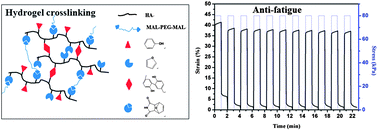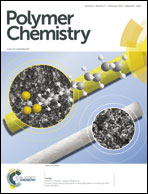An injectable hyaluronic acid/PEG hydrogel for cartilage tissue engineering formed by integrating enzymatic crosslinking and Diels–Alder “click chemistry”
Abstract
The application of enzymatic crosslinking and Diels–Alder (DA) click chemistry for hydrogel formation has recently bloomed, because of the efficient chemical bonding and the mild biological reaction conditions. In this study, an injectable hyaluronic acid/PEG (HA/PEG) hydrogel was successfully fabricated for the first time through integrating two cross-linking processes, including firstly enzymatic crosslinking and subsequent DA click chemistry. The enzymatic crosslinking resulted in a fast gelation of HA/PEG in 5 min, leading to the formation of an injectable material. In addition, the DA click reaction crosslinking made a hydrogel that has outstanding shape memory and anti-fatigue properties. The storage modulus and breakage strength of the hydrogels were close to 27 kPa and 109.4 kPa, respectively. The compressive strain could reach up to 81.9%. After 10 cycles of a loading and unloading test, the hydrogel still could be loaded by 80 kPa for 1 min and the corresponding deformation could be completely recovered in 1 min after unloading. The ATDC-5 cells were capsulated into the hydrogel bulk in situ and showed high metabolic viability and proliferation. All of these results suggest that the HA/PEG injectable hydrogel formed by integrating the two cross-linking processes has a great potential in cartilage tissue engineering.


 Please wait while we load your content...
Please wait while we load your content...